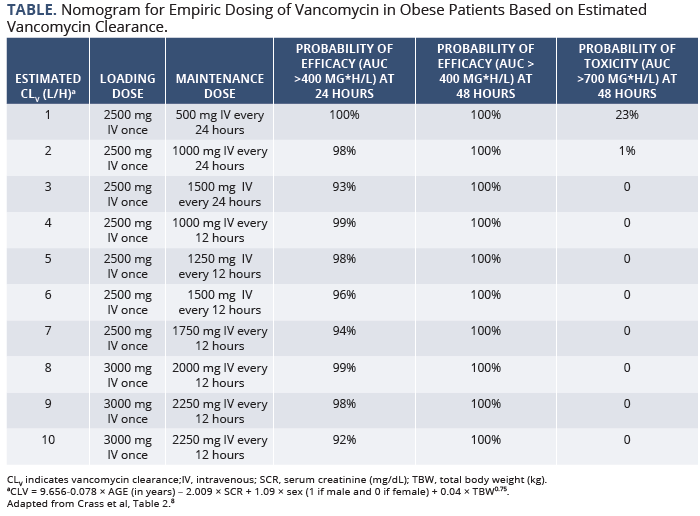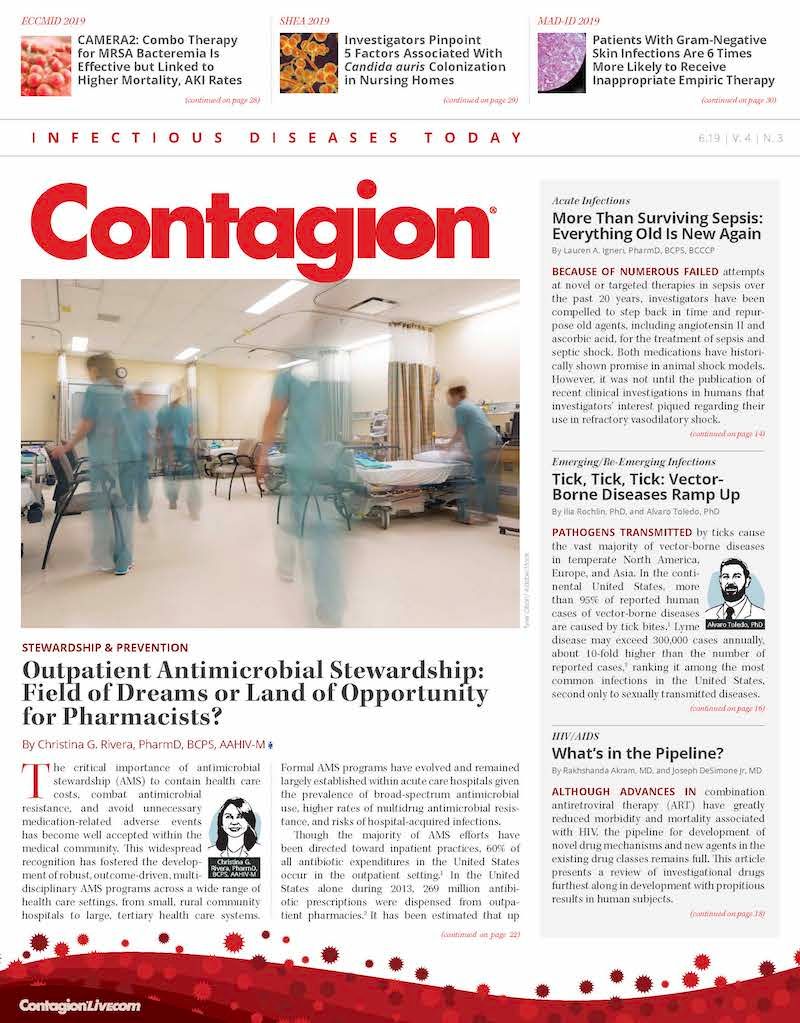Optimal Vancomycin Dosing in Obese Patients: Moving Toward the AUC
This In the Literature piece explores if we can mitigate some of the adverse reactions that are being seen in obese patients who receive vancomycin through AUC-dosing.
Highlighted Study:
Crass RL, Dunn R, Hong J, Krop LC, Pai MP. Dosing vancomycin in the super obese: less is more. J Antimicrob Chemother. 2018;73(11):3081—3086. doi: 10.1093/jac/dky310.
Vancomycin is the principal antimicrobial agent used to treat methicillin-resistant Staphylococcus aureus (MRSA)—associated invasive infections. The 2011 Infectious Diseases Society of America (IDSA) MRSA guidelines recommend that vancomycin be dosed at 15 to 20 mg/kg/dose (actual body weight) every 8 to 12 hours, not to exceed 2 g per dose, in patients with normal renal function.1 These guidelines state that “trough vancomycin concentrations are the most accurate and practical method to guide vancomycin dosing…Monitoring of peak vancomycin concentrations is not recommended.” However, obesity presents a unique dilemma, as actual body weight dosing of vancomycin could lead to large, potentially nephrotoxic doses.
Various studies have attempted to address the conundrum of weight-based dosing in obese patients.2-5 Important to this debate is the concept that the actual pharmacokinetic goal in vancomycin dosing is an AUC (area under the curve) ≥400 mg∙h/L, which a vancomycin trough concentration of 15 to 20 mg/L approximates. However, this trough goal can result in significant variability in the AUC achieved, particularly in obese patients.4,6 With this in mind, it may be preferable to directly target the AUC, which reflects a patient’s total exposure to a drug over a given time, as opposed to using the trough concentration as a proxy measure.2,7
Crass and colleagues have provided a noteworthy pharmacokinetic study that helps address this issue8 (Table). The goal of the research was to develop an initial dosage strategy that produces an AUC that is efficacious (≥400 mg∙h/L) but not toxic (defined by the authors as <700 mg∙h/L). They conducted a study using peak (1 hour after infusion) and trough (30 minutes prior to next infusion) levels in obese patients. Then, via Monte Carlo simulation, they identified doses that were predicted to meet AUC goals. A total of 346 nonpregnant adults receiving vancomycin for >48 hours were included, with body weights of 69.6 to 293.6 kg and body mass indexes of 30.1 to 85.7 kg/m2. Patients with creatinine clearance <30 mL/min or serum creatinine increase of 0.5 mg/dL (or 50%) above baseline were excluded. Monte Carlo simulations with a goal AUC of ≥400 mg∙h/L and <700 mg∙h/L were run with a wide variety of potential dosing schemes. Based on this simulation, the authors proposed a vancomycin dosage nomogram that can be safely used to achieve pharmacodynamic end points. This uses vancomycin clearance, which is calculated from a regression equation using Cockcroft-Gault variables, to calculate maintenance dosages that range from 500 mg every 24 hours to 2250 mg every 12 hours. Implementing this would result in very few patients receiving maintenance vancomycin dosage in excess of 4.5 g per day.

The authors make 3 major recommendations, the first of which is a shift away from empiric weight-based nomograms to nomograms specifically targeting AUC. The second suggestion is to perform subsequent therapeutic drug monitoring using the AUC via a peak and trough strategy rather than a trough-only approach. The final recommendation is that less is more; the algorithm led to significantly lower overall vancomycin doses than would have been used in dosing based on actual body weight yet had a higher chance of AUC target attainment.
The study has several limitations: First, the patient clinical status and the indication to provide vancomycin were excluded. Additionally, monitoring of peak and trough serum vancomycin levels requires additional phlebotomy. Alternatively, Bayesian software programs can estimate the AUC with a single drug concentration.9 The exclusion of patients with fluctuating renal function is significant, as this is not an uncommon occurrence in hospitalized patients with severe infections and likely represents a group at increased risk of vancomycin nephrotoxicity. Most important, this is a modeling study, and prospective clinical trials in obese patients looking at hard outcomes— microbiological cure and drug-toxicity rates— are much needed. The authors have provided the opportunity to reassess current guidelines and traditional vancomycin therapeutic drug monitoring strategies. Their study aligns well with expected updated IDSA vancomycin guidelines, set to be released in 2019, which are predicted to advocate for AUC-based dosing.
Hale is an infectious diseases physician at the University of Vermont Medical Center and assistant professor of medicine at Larner College of Medicine at the University of Vermont, Burlington, VT. Dimarco is an infectious diseases fellow at the University of Vermont Medical Center, Burlington, VT. Ahern is a clinical infectious diseases pharmacist at the University of Vermont Medical Center and Larner College of Medicine at the University of Vermont, Burlington, VT.* Ahern is a member of the Society of Infectious Disease Pharmacists
References:
1. Liu C, Bayer A, Cosgrove SE et al; Infectious Diseases Society of America. Clinical practice guidelines by the Infectious Diseases Society of America for the treatment of methicillin-resistant Staphylococcus aureus infections in adults and children. Clin Infect Dis. 2011;52(3):e18-e55. doi: 10.1093/cid/ciq146.
2. Durand C, Bylo M, Howard B, Belliveau P. Vancomycin dosing in obese patients: special considerations and novel dosing strategies. Ann Pharmacother. 2018;52(6):580-690. doi: 10.1177/1060028017750084.
3. Rybak MJ, Boike SC. Individualized adjustment of vancomycin dosage: comparison with two dosage nomograms. Drug Intell Clin Pharm. 1986;20(1):64-68.
4. Cantú TG, Yamanaka-Yuen NA, Lietman PS. Serum vancomycin concentrations: reappraisal of their clinical value. Clin Infect Dis. 1994;18(4):533—543.
5. Finch NA, Zasowski EJ, Murray KP, et al. A quasi-experiment to study the impact of vancomycin area under the concentration-time curve-guided dosing on vancomycin-associated nephrotoxicity. Antimicrob Agents Chemother. 2017;61(12):e01293-e013017. doi: 10.1128/AAC.01293-17.
6. Pai MP, Neely M, Rodvold KA, Lodise TP. Innovative approaches to optimizing the delivery of vancomycin in individual patients. Adv Drug Deliv Rev. 2014;20;77:50—7. doi: 10.1016/j.addr.2014.05.016.
7. Drennan PG, Begg EJ, Gardiner SJ, Kirkpatrick CMJ, Chambers ST. The dosing and monitoring of vancomycin: what is the best way forward [published online December 29, 2018]? Int J Antimicrob Agents. doi: 10.1016/j.ijantimicag.2018.12.014.
8. Crass RL, Dunn R, Hong J, Pai MP. Dosing vancomycin in the super obese: less is more. J Antimicrob Chemother. 2018;73(11):3081—3086. doi: 10.1093/jac/dky310.
9. Turner RB, Kojiro K, Shephard EA, et al. Review and validation of Bayesian dose-optimizing software and equations for calculation of the vancomycin area under the curve in critically ill patients. Pharmacotherapy. 2018;38(12):1174—1183. doi: 10.1002/phar.2191.

